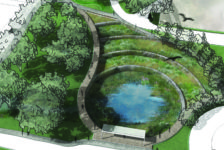Once again, this week’s Linescapes covers analytical drawing. As I emphasized many times before, drawing can be a great tool for analysis. I use it most frequently to record my thoughts when looking at a landscape. It also helps me analyze its shapes and patterns.
When analyzing a landscape, all kinds of background information is useful. I try to inquire about the processes that shaped the landscape, its geological structure, plant sociology and even history. The more we know about an environment, the more we are able to see and perceive.
RELATED STORY: Hand Drawing Tutorial – Analytical Section Drawing
First, I draw the main features of the landscape. I outline the most visible lines, shapes and directions. Even if we don’t see an element in the landscape, we know its there. For example, the river in the distance, which while we can’t see it, we can still draw it. This is because an architectural drawing does not try to depict an actual image seen, but rather the one perceived.
After that, I move on to other textures in the drawing. An analytical drawing sometimes uses abstract forms to emphasize certain information. In the video below, this is visible in the abstract bottom edge of the drawing that emphasizes the geometry of the fields. I use color to emphasize the filed structure and different field use. Some sections are wheat, some corn and many of them are pastures. I do not color the whole image but use the color selectively – only on the landscape feature I’m interested in. This emphasizes the fields and is also a tool for analyzing.
Another layer of information that you can add to your drawing are the names of hills, rivers and important places. I write them vertically which gives those points more of a landmark feeling. In this way writing is also clearly distinguishable from the rest of the drawing.
Once again, I encourage you to try to look at drawing as a tool for analysis and try this technique out for yourselves!
You can also follow Linescapes on Youtube, Twitter, and Facebook!
Published in Blog









